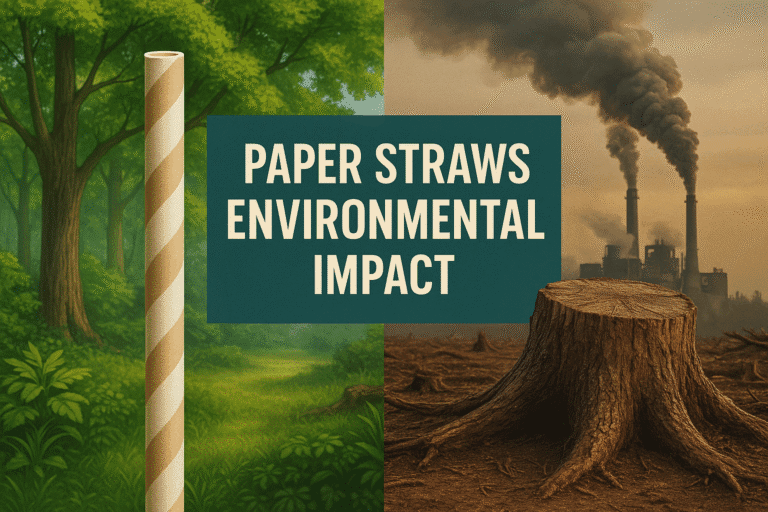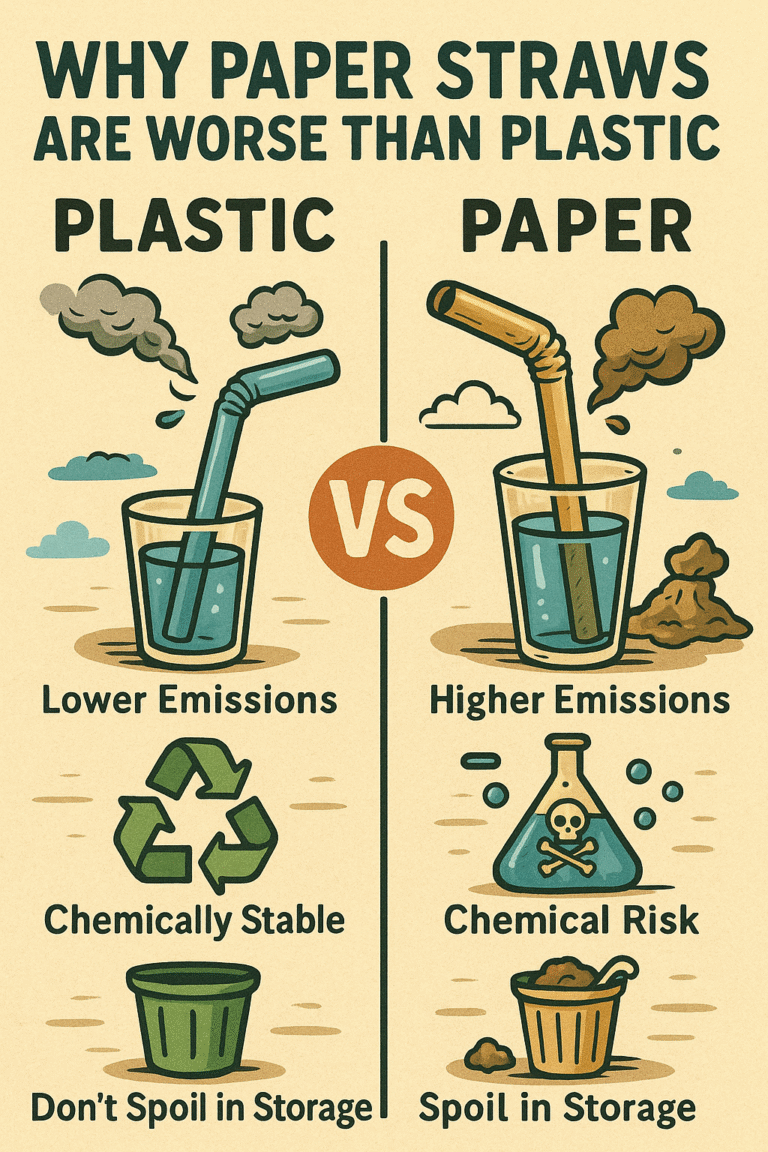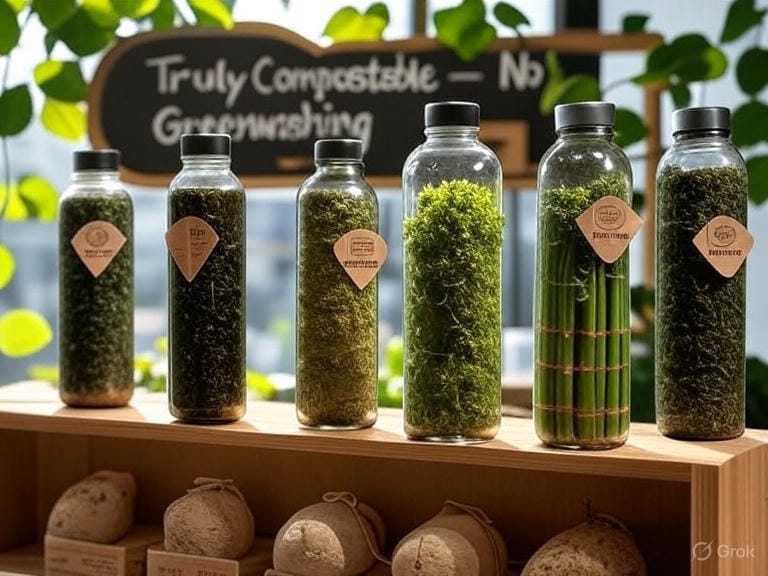
Table of Contents
ToggleAre paper Straws really Eco-friendly?
Nowadays, you may find Paper straws everywhere, like iced lattes, clinging to smoothie cups, and they are offered like a badge of eco-conscious honor. In just a few years it has gone from Novelty to norm. But there is a truth – paper straws environmental impact, are they really Eco-friendly ?
Behind every paper straw there is a trail : energy-hungry pulp factories, chemically treated coatings, and carbon-heavy shipping routes. Forests are quietly being chopped down to meet rising demands. Yet most consumers will sip and toss. They will never consider whether that feel-good swap was actually better for the planet or not. This blog takes a deeper look at the actual paper straws’ environmental impact rather than just what many brands claim. You might be surprised at what’s hidden behind that biodegradable label.
8 Hidden Paper straws environmental impact
When people think about paper straws they think “biodegradable natural and harmless”. But the environmental food print behind that soggy brownie’s tube tells us a different story: resource waste, hidden chemicals, and false green comfort. Here is a proper breakdown of the environmental impact of eight paper straws.
1. Forests are being cut down
Paper straws aren’t typically made from recycled material they require virgin pulp. That pulp often comes from large-scale logging operations that target fast-growing softwoods. Despite this deforestation, it may not grab headlines like the Amazon fires do. The life of a tree is reduced to a single-use sip. Over time, this adds up to a massive ecological loss for biodiversity, carbon storage, and climate regulation.
2. Manufacturing process emits More CO² than plastic
You heard right. Despite dear Eco image the carbon footprint of a paper straw can be 2-3 times higher than a plastic one. But why ? Because paper production is energy-intensive, it involves pulping, bleaching, pressing, and drying. And when it is done in countries that are reliant on coal-fired power, like China or India, the emissions increase into the sky. So that “greener” paper straw may come with a blacker cloud.
3. Massive Water Consumption for a Disposable Product
It takes 4 to 10 litres of water to produce just one paper straw and that’s before you even sip. Bleaching and pulping require clean water in large quantities. In a world that is already facing acute water stress, especially in production hubs, using gallons of drinkable water is extremely stupid and defines poor sustainability math.
4. Chemical coatings make them Natural
To avoid becoming mush in your drink these paper straws are treated with waterproof coating. Many of these chemical includes synthetic resins or PFAS (per- and polyfluoroalkyl substances) – they are often referred as forever chemicals. These substances resist the breaking process in nature and can leach into liquids. They are linked to health concerns including hormone disruption and cancer.
5. They Don’t break Down Easily
The biodegradability of paper straws is heavily overstated. In controlled composting, they may degrade, but in real-world landfills or the ocean, the breakdown process becomes slow. And as we have discussed, these coatings, dyes, and dense compaction hinder natural decomposition, and in many cases, they persist just as long as low-grade plastic.

6. They Can’t Be Recycled
Another environmental problem with paper straws is that they cannot be recycled, and they often contaminate other waste as well. Ironically, most municipal recycling systems reject paper straws. Their small size, mixed material and food contamination mean they are sorted out and landfilled. They are Worse if thrown into recycling bins because they contaminate entire batches of clean recyclable materials, and it leads to more waste.
7. Storage Waste Is a Hidden Problem
Paper straws are sensitive to humidity, air exposure and shelf life. Restaurants and businesses often discard large batches due to early softening, mold or warping. These never-used straws end up in trash bins and generate pre-consumer waste that is invisible to most eco-impact assessments.
8. They Create a False Sense of Progress
The most damaging aspect of paper straws” environmental impact may be psychological. Paper straws offer a sense of doing the right thing which can lull both consumers and corporations into complacency. Meanwhile the bigger issues like over consumption, packaging waste or global supply chain remain Unchallenged. In effect, they greenwash reality and offer a feel-good fix, while deeper problems worsen situations.

Why Paper Straws Are Worse Than Plastic
The entire reason paper straws became popular is because plastic ones were seen as villains. Plastics were polluting oceans, choking marine life, and clogging landfills. But during the rush to ban plastic we stopped asking: Is paper really better than plastic ?
One of the major environmental impacts of paper straws is that these paper straws generate lots of greenhouse gas emissions during manufacturing. Deforestation, pulping, and energy-heavy drying their production can emit up to 3x more C0² than plastic straws, especially when they’re made in countries with dirty power grids. There are lots of alternatives to plastic and paper straws.
Plastic straws can at least maintain structure throughout an entire drink. But paper straws ? They often start degrading in the mid-sip. This compelled consumers to use multiple straws per drink which ironically increases materials and waste. In cafes and fast food outlets, this effect quietly doubles the consumption footprints.
Unlike plastic straws that can be stored for years without damage, paper straws are fragile and sensitive to humidity and heat. Many businesses report high spoilage rate. Boxes are thrown away before even reaching customers. This has wasted pulp, energy, chemicals, packaging, and transportation.
Plastic straws may be synthetic but they’re chemically stable when they’re made to food-grade standards. On the other hand, paper straws are often treated with waterproof coatings that contain PFAS, which are chemically linked to cancer, thyroid disease, and developmental issues.
Plastic straws are not widely recyclable level but neither are paper straws. Paper straws serve as a convenient distraction from far bigger threats like plastic bags, containers, wrappers, and the broader overconsumption culture. Their feel-good aesthetic gives us the illusion of change, which can stall meaningful reforms in packaging policy and corporate responsibility.
Do paper straws contain PFAS?
PFAS (per- and polyfluoroalkyl substances) are persistent synthetic compounds that are resistant to grease,water, and heat, which makes them useful for waterproofing. The White House’s domestic policy council highlights that PFAS are often added to products like paper straws to help them resist sogginess and oil.
However, PFAS persist in the environment and the human body due to their chemical stability. The EPA lists health risks that include hormone disruption, cancer, developmental delays and reproductive issues across vulnerable populations.
Key Takeaways
Paper straws aren’t automatically PFAS-safe, and unless certified PFAS-free, they may contribute to chemical pollution despite appearing biodegradable. The only PFAS-free category tested reliably is stainless steel. Regulatory momentum which includes hazardous destinations signals that PFAS use in paper food contact products is being heavily scrutinized and phased out.

How to choose safer and truly non toxic straws ?
As the concern of PFAS in paper straws is growing many consumers are left wondering about any straws that is actually safe ? The short answer is yes, you can counter the environmental impact of paper straws, but only if you can cut through the greenwashing and know how to find them.
You have to look for PFAS-Free Certifications — Not Just “Eco-Friendly” Labels. What’s like biodegradable is often unregulated and meaningless. Hence you should check for – PFAS-free or Fluorine-free. Follow those Brands that publicly disclose lab testing or PFAS reports (rare but growing).
Avoid bamboo straws unless the brand is tested because many straws are coated or glued with harmful adhesives. The safest reusable options are made of non-reactive, PFAS-free materials are –
- Borosilicate Glass
- Medical-Grade Silicone
- 304 or 316 Stainless Steel
Beware of Compostable greenwashing. Many so-called compostable straws are made from PLA or CPLA, which require industrial composting facilities, and they won’t break down in your backyard bin. Some compostable products also contain PFAS to resist moisture. If the company does not clearly state PFAS-free on certified documents, then just skip it.
FAQs
Are paper straws better than plastic straws ?
Paper straws degrade much faster than plastic straws. Typically, the breakdown occurs within weeks in composting conditions. However, their overall environmental benefit depends on production methods, transportation emissions, and how they are disposed of. In low-waste systems, paper straws are more eco-friendly, but if contaminated, they can still cause harm.
What is the carbon footprint of producing paper straws?
Paper straws avoid fossil fuel-based plastic, but they often require more energy and water to manufacture. Producing a paper straw can emit 30%-70% more CO² than a plastic straw if deforestation and water-intensive pulp processing are involved. Sourcing FSC-certified recycled paper can reduce the environmental impact of paper straws.
Paper straws Environmental impact is true ?
Yes, paper straws can still contribute to deforestation, high water use, and micro waste if they aren’t properly composted. Some paper straws contain PFAS coatings, which make them non-biodegradable and harmful to aquatic life.
